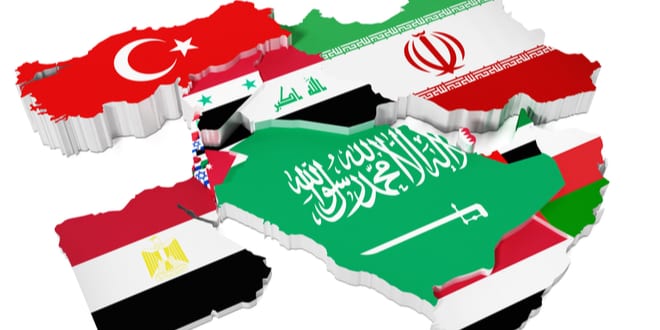The U.S. State Department has long assumed that generous diplomatic and financial gestures can convince the volatile Middle East to abandon anti-Western ideologies and adopt Western values like peaceful coexistence, good faith negotiation, democracy and human rights. However, the State Department’s well-intentioned policy has fueled Middle East violence, generating tailwinds to rogue entities and headwinds to the U.S. and its Arab allies.
For example:
The State Department welcomed the turbulence on the Arab Street that erupted in 2010 and is still raging from the Persian Gulf to northwest Africa as “the Arab Spring,” a “Facebook and youth revolution” and a “march for peace and democracy.” However, as evidenced by Middle East reality, it has been another tectonic Arab Tsunami, not an Arab Spring.
The State Department’s policy on Iran since 1979 has favored the diplomatic option, assuming that a financial and diplomatic bonanza could entice the ayatollahs to be good-faith negotiators amenable to peaceful coexistence with their Arab Sunni neighbors. It was also hoped that such a windfall would convince the mullahs to desist from their anti-U.S. regional and global proliferation of terrorism and drug trafficking and to abandon their repressive, fanatical and megalomaniacal 1,400-year-old ideology. However, this policy has bolstered the ayatollahs’ anti-U.S. rogue strategy, reinforcing their collaboration with anti-U.S. governments, terror organizations and drug traffickers in Latin America, posing a lethal threat to every pro-U.S. Arab regime and letting down most Iranians, who want regime change in Tehran.
The State Department was also a key engine behind the U.S.-led NATO military offensive that toppled Libya’s Muammar Qaddafi in 2011, notwithstanding his dismantling of Libya’s nuclear and chemical warfare infrastructure and fervent war on Islamic terrorism. The toppling of Qaddafi transformed Libya into an uncontrollable platform for civil wars and anti-U.S. global Islamic terrorism.
Until the eruption of the civil war in Syria, the State Department considered the ruthless anti-U.S. dictator Bashar Assad a potential reformer due to his background as an ophthalmologist in London, president of the Syrian Internet Association and marriage to a British-born woman. However, the civil war has resulted in over 500,000 casualties, seven million refugees and a similar number of domestically displaced people.
The State Department has embraced the anti-U.S. Muslim Brotherhood—the largest Sunni Islamic terror organization with welfare, political and religious branches—while pressuring the pro-U.S. Saudi Arabia, the United Arab Emirates and Egypt because of their war on Muslim Brotherhood terrorism. The pro-U.S. Arab regimes know that the Muslim Brotherhood aims to topple all national Islamic governments, establish a universal Islamic despotism, promote martyrdom in the service of Allah and force the Western “infidel”—especially the U.S.—to submit. This State Department policy is pushing pro-U.S. Arab regimes closer to China and Russia.
From 1993-2000, the State Department extended the red carpet treatment to the anti-U.S. Yasser Arafat as a messenger of peace, worthy of the Nobel Prize and annual U.S. foreign aid, ignoring his intra-Arab terroristic and treacherous track record, as well as his annihilationist vision, as reflected by his hate education and 1959 and 1964 Fatah and PLO charters. Meanwhile, all pro-U.S. Arab regimes extended the shabby doormat treatment to Arafat.
From 1980-1990, the U.S. collaborated with the anti-U.S. Saddam Hussein, assuming that “the enemy of my enemy is my friend.” However, this policy was perceived by Saddam as a green light for the invasion of Kuwait, which led to the Gulf War and the Iraq War, as well as an ongoing civil war in Iraq with nine million refugees and domestically displaced people. This transformed Iraq into a major Iranian platform of anti-U.S. regional and global terrorism.
In 1978-1979, the State Department embraced the anti-U.S. Iranian fanatic Ayatollah Khomeini, suggesting that he was anti-Communist, surrounded by moderate advisors and preoccupied with bringing liberty to Iran—a Gandhi-like Iranian.
During the 1950s, the State Department courted the pro-Soviet, anti-U.S. Egyptian President Gamal Abdel Nasser, who strove to topple pro-U.S. oil-producing Arab regimes at a time when the U.S. was heavily dependent upon Persian Gulf oil.
All of the U.S. State Department’s Israeli-Arab peace proposals were Palestinian-centered, and therefore frustrated by Middle Eastern reality, which has never perceived the Palestinian issue of primary concern, considering Palestinians as a role model of intra-Arab subversion, terrorism and ingratitude.
In 1948, the State Department led the opposition to the establishment of Israel, contending that it would be pro-Soviet and overrun by the expected Arab military invasion. It believed Israel would destabilize the Middle East and threaten the supply of Arab oil.
Today, exposing the State Department’s detachment from Middle East reality, Israel constitutes the largest U.S. aircraft carrier with no need for U.S. servicemen, sparing the U.S. the need to deploy real aircraft carriers and additional ground divisions to the Mediterranean and the Indian Ocean.
Vital U.S. interests require the State Department to base its policy on Middle East reality, as complex and frustrating as it may be, and learn from its own track record by avoiding—rather than repeating—critical past mistakes.
Reprinted with author’s permission from Jewish News Syndicate



